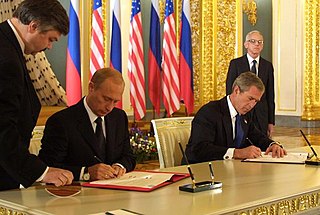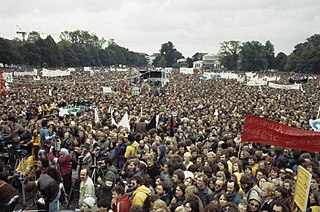
The Anti-Ballistic Missile Treaty (1972–2002) was an arms control treaty between the United States and the Soviet Union on the limitation of the anti-ballistic missile (ABM) systems used in defending areas against ballistic missile-delivered nuclear weapons. It was intended to reduce pressures to build more nuclear weapons to maintain deterrence. Under the terms of the treaty, each party was limited to two ABM complexes, each of which was to be limited to 100 anti-ballistic missiles.

An intercontinental ballistic missile (ICBM) is a ballistic missile with a range greater than 5,500 kilometres (3,400 mi), primarily designed for nuclear weapons delivery. Conventional, chemical, and biological weapons can also be delivered with varying effectiveness, but have never been deployed on ICBMs. Most modern designs support multiple independently targetable reentry vehicles (MIRVs), allowing a single missile to carry several warheads, each of which can strike a different target. Russia, the United States, China, France, India, the United Kingdom, and North Korea are the only countries known to have operational ICBMs.
Arms control is a term for international restrictions upon the development, production, stockpiling, proliferation and usage of small arms, conventional weapons, and weapons of mass destruction. Arms control is typically exercised through the use of diplomacy which seeks to impose such limitations upon consenting participants through international treaties and agreements, although it may also comprise efforts by a nation or group of nations to enforce limitations upon a non-consenting country.

The Strategic Arms Limitation Talks (SALT) were two rounds of bilateral conferences and corresponding international treaties involving the United States and the Soviet Union. The Cold War superpowers dealt with arms control in two rounds of talks and agreements: SALT I and SALT II.

START I was a bilateral treaty between the United States and the Soviet Union on the reduction and the limitation of strategic offensive arms. The treaty was signed on 31 July 1991 and entered into force on 5 December 1994. The treaty barred its signatories from deploying more than 6,000 nuclear warheads and a total of 1,600 intercontinental ballistic missiles (ICBMs) and bombers.

The Intermediate-Range Nuclear Forces Treaty was an arms control treaty between the United States and the Soviet Union. US President Ronald Reagan and Soviet General Secretary Mikhail Gorbachev signed the treaty on 8 December 1987. The US Senate approved the treaty on 27 May 1988, and Reagan and Gorbachev ratified it on 1 June 1988.

The nuclear arms race was an arms race competition for supremacy in nuclear warfare between the United States, the Soviet Union, and their respective allies during the Cold War. During this same period, in addition to the American and Soviet nuclear stockpiles, other countries developed nuclear weapons, though none engaged in warhead production on nearly the same scale as the two superpowers.

The Russian Federation is known to possess or have possessed three types of weapons of mass destruction: nuclear weapons, biological weapons, and chemical weapons. It is one of the five nuclear-weapon states recognized under the Treaty on the Non-Proliferation of Nuclear Weapons.

The United States is known to have possessed three types of weapons of mass destruction: nuclear weapons, chemical weapons, and biological weapons. The U.S. is the only country to have used nuclear weapons in combat, when it detonated two atomic bombs over the Japanese cities of Hiroshima and Nagasaki during World War II. It had secretly developed the earliest form of the atomic weapon during the 1940s under the title "Manhattan Project". The United States pioneered the development of both the nuclear fission and hydrogen bombs. It was the world's first and only nuclear power for four years, from 1945 until 1949, when the Soviet Union produced its own nuclear weapon. The United States has the second-largest number of nuclear weapons in the world, after the Russian Federation.

START II was a bilateral treaty between the United States and Russia on the Reduction and Limitation of Strategic Offensive Arms. It was signed by US President George H. W. Bush and Russian President Boris Yeltsin on 3 January 1993, banning the use of multiple independently targetable re-entry vehicles (MIRVs) on intercontinental ballistic missiles (ICBMs). Hence, it is often cited as the De-MIRV-ing Agreement.

The Treaty Between the United States of America and the Russian Federation on Strategic Offensive Reductions (SORT), also known as the Treaty of Moscow, was a strategic arms reduction treaty between the United States and Russia that was in force from June 2003 until February 2011 when it was superseded by the New START treaty.

As the collapse of the Soviet Union appeared imminent, the United States and their NATO allies grew concerned of the risk of nuclear weapons held in the Soviet republics falling into enemy hands. The Cooperative Threat Reduction (CTR) program was initiated by the Nunn–Lugar Act, which was authored and cosponsored by Sens. Sam Nunn (D-GA) and Richard Lugar (R-IN). According to the CTR website, the purpose of the CTR Program was originally "to secure and dismantle weapons of mass destruction and their associated infrastructure in former Soviet Union states." As the peace dividend grew old, an alternative 2009 explanation of the program was "to secure and dismantle weapons of mass destruction in states of the former Soviet Union and beyond". The CTR program funds have been disbursed since 1997 by the Defense Threat Reduction Agency (DTRA).

The RT-2PM Topol is a mobile intercontinental ballistic missile designed in the Soviet Union and in service with Russia's Strategic Missile Troops. As of 2014, Russia planned to replace all SS-25 ICBMs with versions of Topol-M.

The Enduring Stockpile is the United States' arsenal of nuclear weapons following the end of the Cold War.
The original Treaty on Conventional Armed Forces in Europe (CFE) was negotiated and concluded during the last years of the Cold War and established comprehensive limits on key categories of conventional military equipment in Europe and mandated the destruction of excess weaponry. The treaty proposed equal limits for the two "groups of states-parties", the North Atlantic Treaty Organization (NATO) and the Warsaw Pact. In 2007, Russia "suspended" its participation in the treaty, and on 10 March 2015, citing NATO's de facto breach of the Treaty, Russia formally announced it was "completely" halting its participation in it as of the next day.

The NATO Double-Track Decision was the decision by NATO from December 12, 1979 to offer the Warsaw Pact a mutual limitation of medium-range ballistic missiles and intermediate-range ballistic missiles. It was combined with a threat by NATO to deploy more medium-range nuclear weapons in Western Europe after the so-called "Euromissile Crisis".
This timeline of nuclear weapons development is a chronological catalog of the evolution of nuclear weapons rooting from the development of the science surrounding nuclear fission and nuclear fusion. In addition to the scientific advancements, this timeline also includes several political events relating to the development of nuclear weapons. The availability of intelligence on recent advancements in nuclear weapons of several major countries is limited because of the classification of technical knowledge of nuclear weapons development.

New START is a nuclear arms reduction treaty between the United States and the Russian Federation with the formal name of Measures for the Further Reduction and Limitation of Strategic Offensive Arms. It was signed on 8 April 2010 in Prague, and, after ratification, entered into force on 5 February 2011. It is expected to last until 5 February 2026, having been extended in 2021.
In nuclear strategy, a counterforce target is one that has a military value, such as a launch silo for intercontinental ballistic missiles, an airbase at which nuclear-armed bombers are stationed, a homeport for ballistic missile submarines, or a command and control installation.

The Moscow Summit was a summit meeting between U.S. President Ronald Reagan and General Secretary of the Communist Party of the Soviet Union Mikhail Gorbachev. It was held on May 29, 1988 – June 3, 1988. Reagan and Gorbachev finalized the Intermediate-Range Nuclear Forces Treaty (INF) after the U.S. Senate's ratification of the treaty in May 1988. Reagan and Gorbachev continued to discuss bilateral issues like Central America, Southern Africa, the Middle East and the pending withdrawal of Soviet troops from Afghanistan. Reagan and Gorbachev continued their discussions on human rights. The parties signed seven agreements on lesser issues such as student exchanges and fishing rights. A significant result was the updating of Soviet history books, which necessitated cancelling some history classes in Soviet secondary schools. In the end, Reagan expressed satisfaction with the summit.















